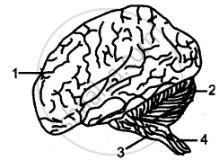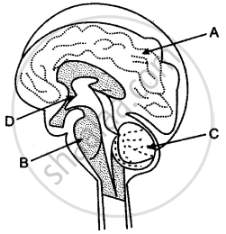Advertisements
Advertisements
प्रश्न
The below diagram represents the human brain as seen in an external view. Study the same and then answer the questions that follow:

(i) Name the parts labeled 1, 2, 3, and 4.
(ii) Mention the difference in the arrangement of the nerve cells in the parts marked ‘1’ and ‘4’.
(iii) What is the main function of the parts marked ‘3’ and ‘4’?
(iv) Name the sheet of nerve fibers that connect the two halves of the part labeled ‘1’.
उत्तर
(i)
1. Cerebrum,
2. Cerebellum,
3. Medulla oblongata,
4. Spinal cord.
(ii)
1. Gray matter is outside and white matter inside.
4. White matter s outside and gray matter is inside.
(iii)
3. Medulla oblongata controls all involuntary movements of internal organs e.g., breathing movements of lungs, beating of the heart.
4. The spinal cord performs reflex action below the neck.
(iv) Corpus callosum.
APPEARS IN
संबंधित प्रश्न
The main function of Cerebrospinal fluid.
Differentiate between Corpus callosum and Corpus luteum (function)
Select the odd one in the following series:
Cerebellum, Medulla oblongata, Olfactory lobe.
Name the following:
The fluid that is present inside and outside the brain.
The below-simplified diagram shows a section through the brain.

(i) Name the parts labeled A, B, and C.
(ii) Give one function of each of the parts A, B, and C.
(iii) What is found in region D?
Identify the odd item from the following series of words.
Site for processing of vision, hearing, memory, speech, intelligence, and thought is ______
Match the following
| A. Nissil’s granules | Forebrain |
| B. Hypothalamus | Peripheral Nervous system |
| C. Cerebellum | Cyton |
| D. Schwann cell | Hindbrain |
The two cerebral hemispheres are joined by a sheet of fibres called ______.
Define the following term:
Corpus callosum
